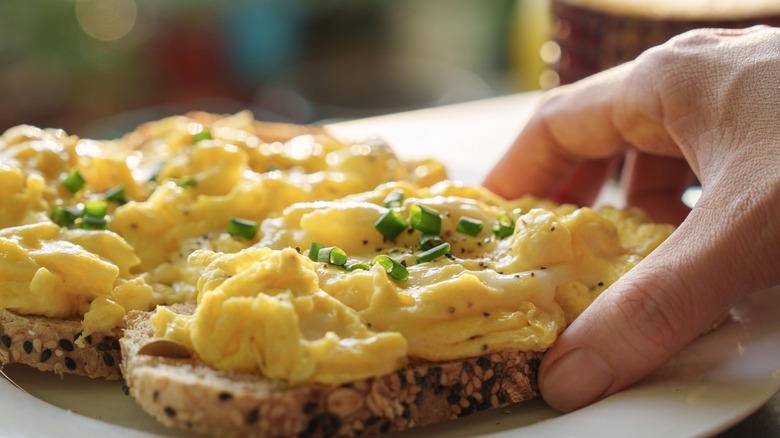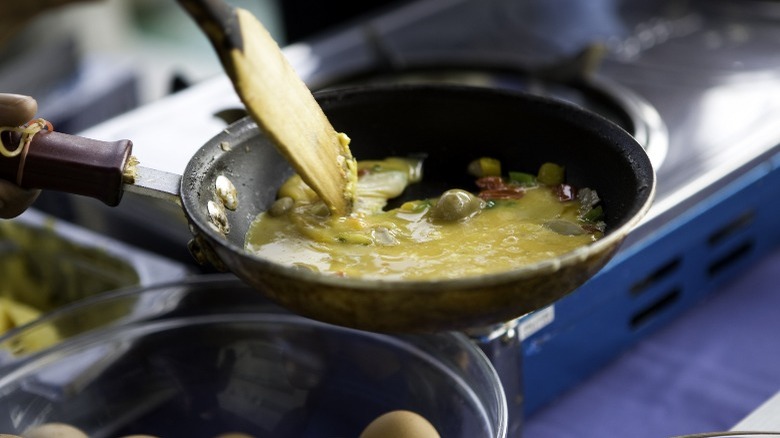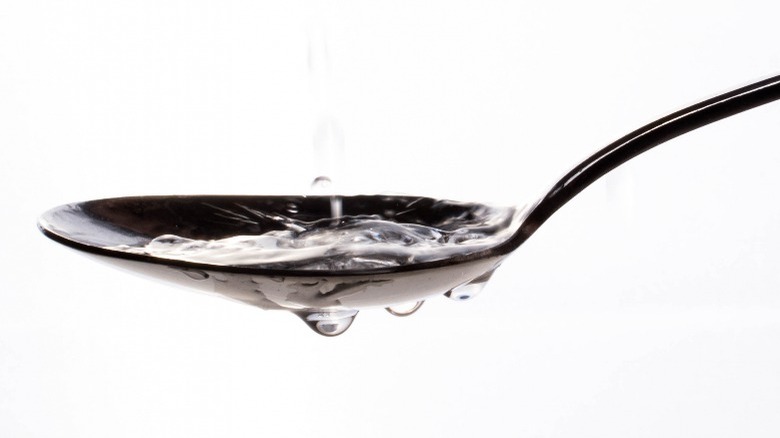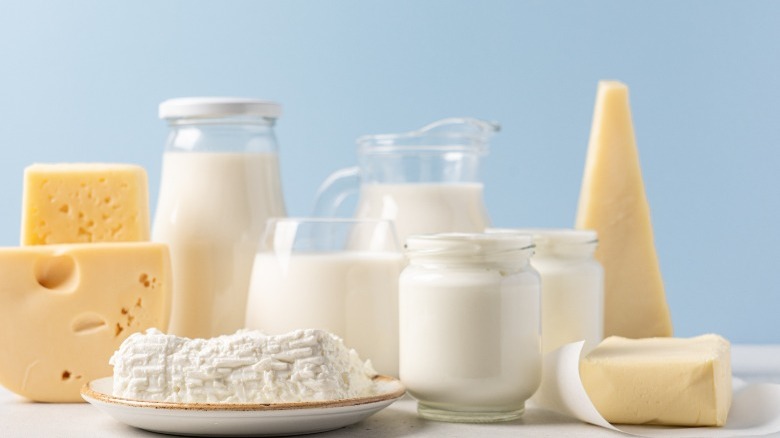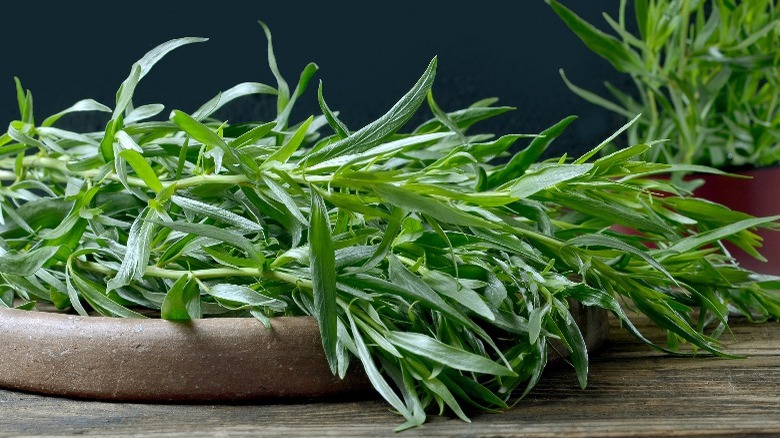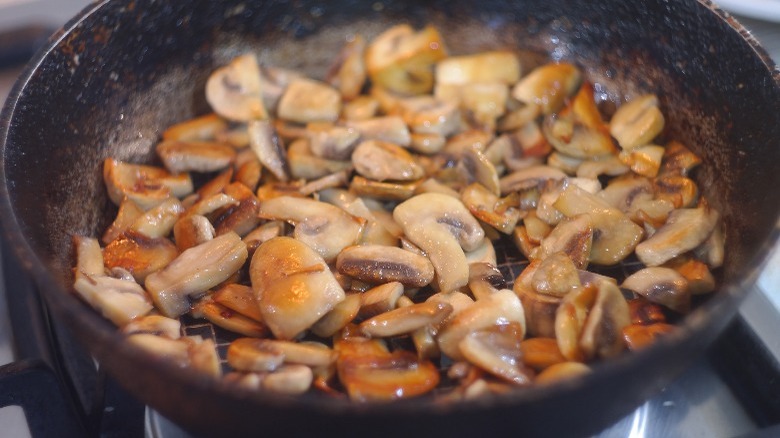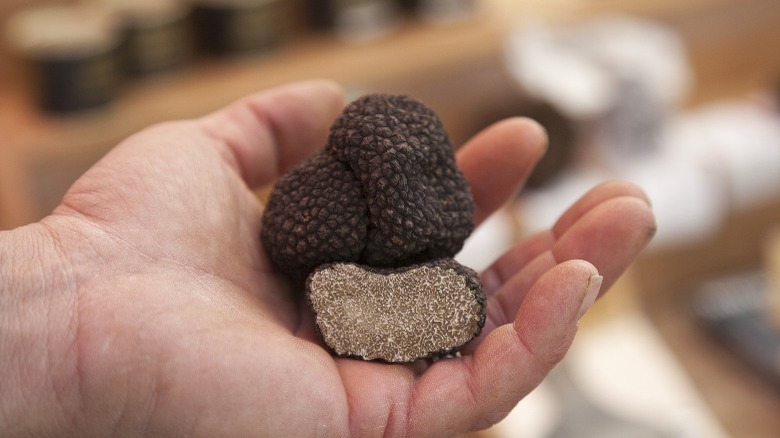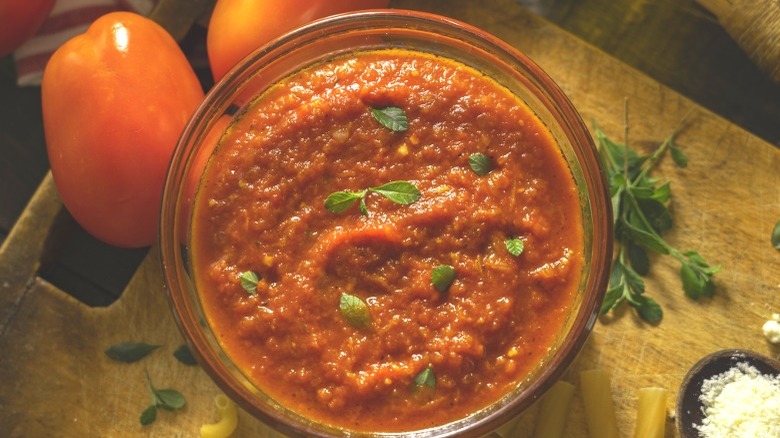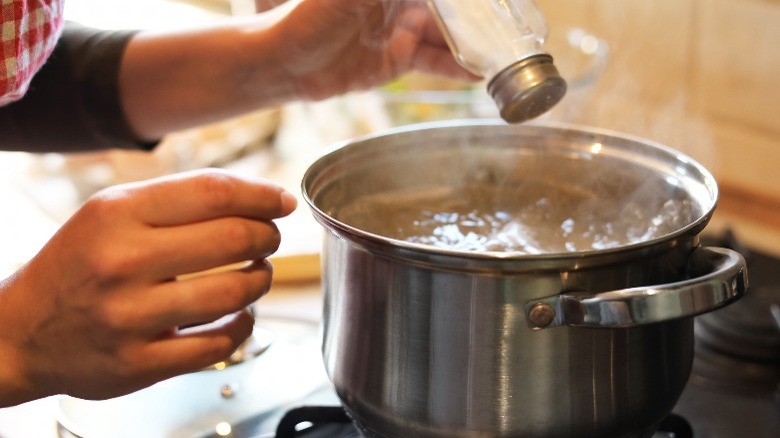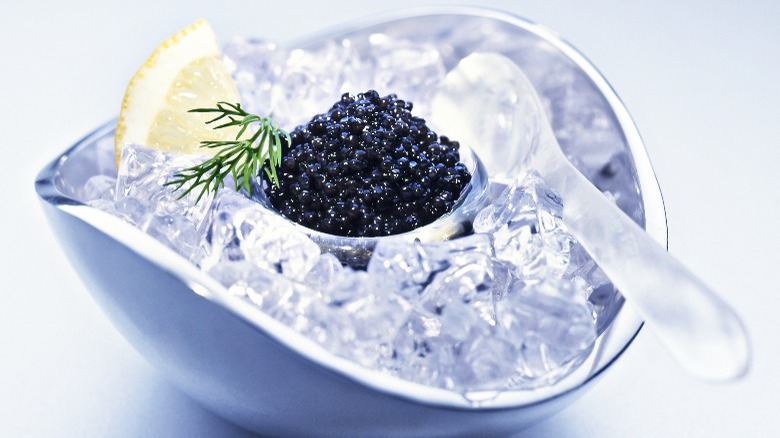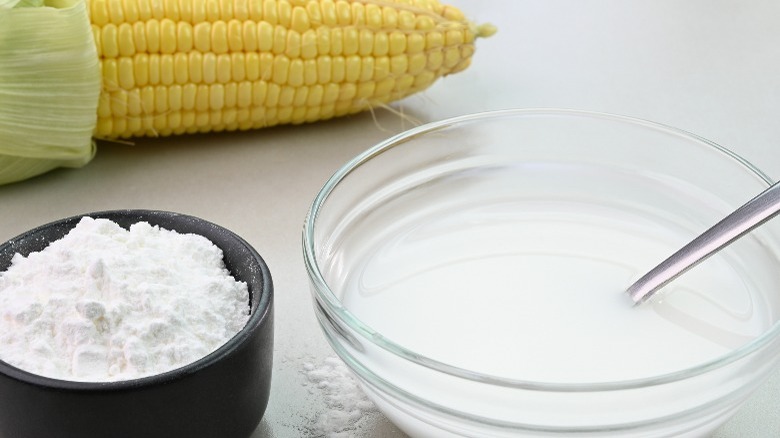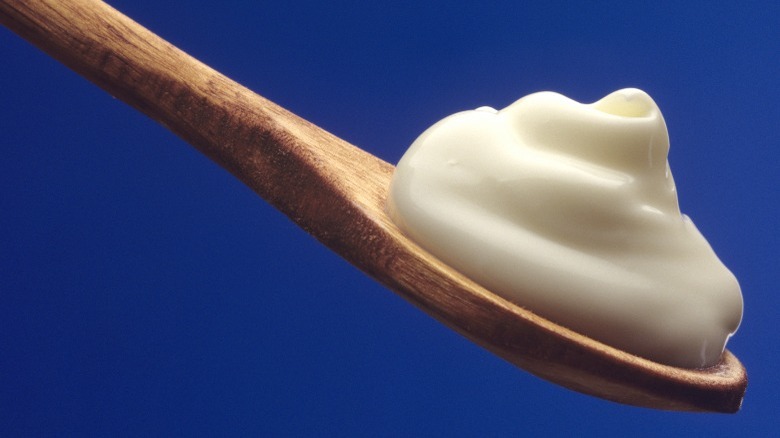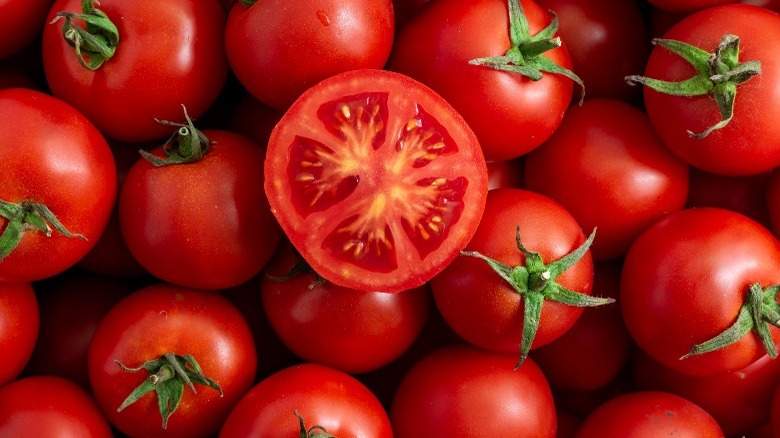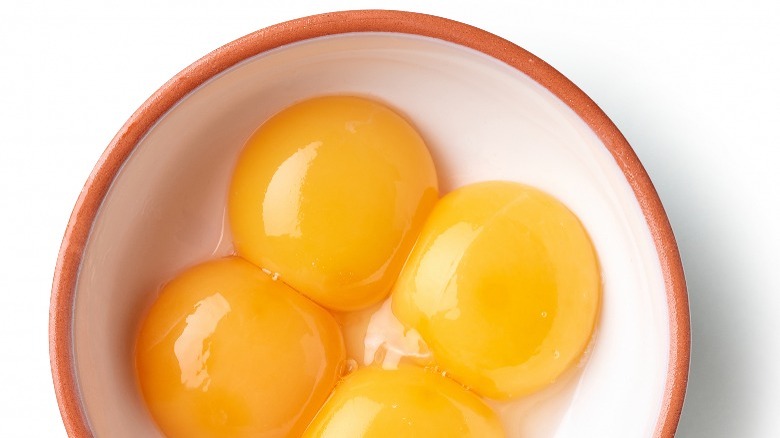15 Ways To Elevate Your Everyday Scrambled Eggs
Scrambled eggs are often thought of as a simple dish, a fact that may be responsible for all the dried-out, uninspiring scrambled eggs that have been served and eaten over the years. But, that simplicity also means it's easy to make scrambled eggs a dish you'll look forward to.
Much of that poor reputation, admittedly, stems from the notion that scrambled eggs are just a quick morning meal undeserving of too much time or effort but when you think of them that way, you're depriving yourself of what could be a lovely — albeit simple — kick-off for the day. Learning how to cook scrambled eggs correctly, and giving yourself a little extra time, could change your mornings forever.
The following tips and recipes are things we have tried or have come from food writers and chefs. It's no surprise that great cooks like James Beard, Crescent Dragonwagon, Diana Kennedy, and others are a wealth of knowledge, even for something as simple as scrambled eggs.
Whether you're serving them in the morning as part of your breakfast, making them part of an elegant brunch, or a late-night meal, scrambled eggs can be so much more. Taking your scrambled eggs to the next level means understanding why eggs cook the way they do, and how to use their innate qualities to make them even better.
Heat is the most important factor
Eggs, like humans, are composed largely of water. In fact, the egg white — also known as albumen — is more than 87% water, while the yolk is about 50% water. If you want luxuriously creamy scrambled eggs, you'll want to keep as much of that moisture in the eggs as possible.
As chemist and food science historian Harold McGee wrote in his classic "On Food and Cooking", "The key to most good egg dishes is temperature control," (via The Washington Post). Water molecules in eggs outnumber protein molecules 1000 to 1. When you expose the eggs to heat, the protein molecules begin to bond to one another, isolating the water molecules (and turning the albumen opaque). But, if you use high heat, this happens very quickly causing the protein molecules to bind together even more tightly, squeezing out the water.
The solution? Cook your eggs slowly over low heat. If you're cooking them in butter, add the well-beaten eggs to the pan just as the butter begins to bubble, and then keep stirring them. Really. Don't stop stirring. This will take longer — about 10 minutes or more — but the results are remarkably creamy eggs. Once the eggs are just about at the consistency you want, remove them immediately from the pan because they'll continue cooking with the residual heat.
Add a teaspoon of water
The most basic addition to scrambled eggs, other than salt and pepper, is water. Adding, say, a teaspoon of water to two eggs as you're mixing them up can help make your scrambled eggs a little lighter because, as they cook, the water heats up and turns to steam, lightening the texture of the eggs.
Cookbook writer Crescent Dragonwagon, author of the old vegetarian classic "The Passionate Vegetarian" suggests adding carbonated water to lighten up the texture. Anyone who's ever made matzo balls will be familiar with that trick, which helps lighten their otherwise dense consistency.
Dolly Parton, the country singer loved by nearly everyone on the planet, has her own twist and told Business Insider that she uses ice water when she scrambles eggs for her husband. "Somebody told me this once and it works," Parton said. "When you crack your eggs in the bowl, say if you're going to scramble them, use ice water. Put a few drops of ice water as you're cooking them and that makes them fluffier — it really does!"
Eggs contain more than 100 volatile flavor components already. If you simply want to enjoy scrambled eggs at their most basic, then water is the way to go. It won't alter the flavor of the eggs, and if you're lucky enough to get your hands on farm-fresh eggs, why would you want to change that?
Add beer for body and flavor
Speaking of carbonated water, Crescent Dragonwagon also suggests using beer instead of water, noting in "The Passionate Vegetarian," "Oddly enough, it's tasty — the eggs taste like themselves, yet with indefinable body and flavor." Another advantage to using beer in your eggs, of course, is that it's less obvious than pouring it over your cereal.
Dragonwagon's not the only one suggesting beer. If you're making a full-on, flavorful scramble including ingredients such as avocado and chorizo, for example, consider adding a flavorful beer such as an amber or an IPA. What you use, ultimately, depends upon your tastes, but beer can certainly help in cutting the heaviness of additional ingredients, such as cheeses, sausage, or perhaps, smoked salmon or trout.
At its most simple, why not just replace the liquid you might normally add to your eggs with the same amount of your favorite beer? The beer lovers in your life will certainly appreciate it.
Add dairy for creamier results
Adding dairy, such as cream or milk, dilutes the egg proteins resulting in more tender, creamier eggs. Noted food writer Eric Ripert suggests a fairly generous amount of cream, adding one full tablespoon per egg. The results, he writes, are "sublime."
Of course, dairy isn't confined to just cream or milk. Consider sour cream or half-and-half, which is just that — a 50/50 blend of whole milk and cream. Lighter than full cream, it gives your scrambled eggs a creaminess with fewer calories and less fat.
Sour cream — or even creme fraiche — takes your eggs to another level completely. Just fold in a spoonful of sour cream just as the eggs are finishing in the pan. Using the same technique, prolific food writer James Beard suggested doing the same with a pat of softened butter writing, "I don't like cream or milk added to scrambled eggs, but if I want them extraordinarily rich, I mix in softened butter," (via The James Beard Foundation).
If you want something more substantial, there's always cheese. Add the cheese once the eggs are nearly finished. They will still hold their fluffy quality and the cheese, if shredded or finely diced, will melt easily enough from the residual heat.
While most of us have cheddar or similar types on hand, try a few different varieties, too: goat cheese, gruyere, and even blue. Its tangy umami flavor is a lively contrast to the subtly flavored, creamy egg curds.
Herbs add freshness
Herbs can enliven almost any dish, adding a wide variety of flavors and depth. If you're lucky enough to have herbs growing at home, there's no excuse for not using them. And, while dried herbs have their place, for something as delicate and simple as scrambled eggs, fresh herbs are the way to go.
So, which herbs do you want to use? That really depends on the flavor you're looking for. Tarragon, an herb much loved by the French, is a terrific addition to eggs. Its mild licorice flavor seems to brighten the eggs themselves but doesn't overwhelm them. We've found basil to offer a similar, but slightly punchier, kick as well.
Try a blend of herbs — parsley, chives, marjoram, whatever you might have around — at a ratio of ¼ cup to two eggs. You might try mixing the herbs into the batter or folding them into the almost-finished eggs before you remove them from the skillet. Blending the herbs into the batter and then garnishing the eggs once they're done with a sprinkling of more of the same herbs also works well.
Proteins create a more substantial dish
Bacon and eggs are a breakfast staple — with whole wheat toast, thank you — but mixing in proteins, bacon included, is a great way to elevate scrambled eggs. Think about adding pre-cooked crumbled breakfast sausage or diced ham or, for a more robustly flavored plate, chorizo. Of course, then you'll have to decide between Mexican or Spanish-style chorizo — but Mexican-style chorizo is best because it crumbles and blends nicely into the egg batter.
Southerners of a certain age may recall another addition to their scrambled eggs that seems to have fallen completely out of fashion: brains. Before refrigeration was common in the South, hog slaughtering took place just as the cold days of winter began to set in and, as was common, every last bit of the hog was utilized. Since brains deteriorate faster than other parts of the pig, they were often the first part to be used up. Of course, you'll need to clean and poach them first but, if you can't find fresh brains anywhere, you can still order them, canned, online.
Adding seafood is also a great way to liven up scrambled eggs. Think of smoked salmon, smoked trout, or even shrimp (which should be cooked beforehand). Fold them into the eggs just as they're about finished in the pan and serve.
Add mushrooms for earthiness
The Mushroom Council –- yes, there is a mushroom council –- advises that the addition of mushrooms to your scrambled eggs will actually allow you to use less salt in your recipe. Mushrooms, they say, "enhance the overall flavor, because of double the impact of umami."
Cremini and button mushrooms are probably the most common and the least expensive but if you're feeling flush, don't forget porcini, morels, and maitake, also known as hen-of-the-woods. Mushrooms lend a meaty, earthy flavor to your eggs but they do need to be cooked before you add them.
Mushrooms also give off a lot of moisture; always cook the water off before adding them, to avoid watery scrambled eggs. Fry them in oil or butter for several minutes, until they start to caramelize and the excess moisture evaporates, then set them aside (adding a little flour to them as they're cooking will also take care of that moisture and help brown the mushrooms a little more, as well). When your eggs are just about cooked, fold the mushrooms in with whatever additional ingredients you might be adding.
Add truffles for luxurious eggs
While all of the additions to scrambled eggs so far have been reasonably priced, perhaps you're looking for an outrageously expensive, yet delicious, way to elevate your eggs. So, why not try truffles?
The pungent, earthy fungi can sell for anywhere from about $40 per pound for the largely regarded as inferior black Chinese truffle, to nearly $4,000 per pound for the Holy Grail of truffles, the Italian white. Truffle oil is a much cheaper alternative but it's cheaper for a reason: it doesn't actually contain any truffles. Relying, instead, on a synthetic ingredient – synthetic 2,4-dithiapentane – truffle oil rarely matches the flavor of the real thing and, used carelessly, can be pretty overwhelming. Or, in the words of American truffle authority and chef, Ken Frank says, "Truffle oil is to truffles what Tang is to orange juice," according to the Nappa Truffle Festival.
Should you find yourself in the enviable position of having a real truffle or two on hand, take some advice from the eloquent, late English food writer, Elizabeth David. David recommended letting thin slices of truffle steep in the scrambled egg mixture for several hours or overnight before you cook it. Otherwise, a few shavings of the pricey fungus on top of the hot eggs will also release their earthy, oaky scent.
Add salsa for a splash of flavor
Mexican-style salsas are widespread, relatively inexpensive, and can be made from huge variety of fruits and vegetables. But,they are also a surefire way to bring both a splash of flavor and freshness to your scrambled eggs, to say nothing of heat.
The addition of salsa, though, deserves some forethought. Mixing it straight into your egg batter can result in watery eggs, so draining the salsa beforehand is a good idea. Do that, too, even if you plan to fold some salsa into your eggs just as they're about finished cooking in the pan. A simple way around that, however, would be to simply garnish your scrambled eggs with salsa when you plate them up (on a warmed plate, of course).
Another way to reduce the moisture of your salsa is to fry it in the pan before adding the eggs. Not only does it warm up the salsa, but it also evaporates some of the excess moisture.
Poach your scrambled eggs
Even if poaching your scrambled eggs seems counterintuitive, it's a method that produces incredibly light eggs without the addition of butter or oil. Start by whisking the yolk and white in a bowl, while bringing a pan filled with about 4 inches of lightly salted water brought to a low boil.
Now comes the fun part. Stir the water clockwise until it forms a small whirlpool. Then, pour in your egg batter and cover the pot for a minute or so. Then turn off the heat, uncover the pot, and strain the eggs into a fine mesh strainer pour off the water, and then gently let the eggs continue draining.
Give the eggs another light press to force out any excess water and you're good to go. From this point, you can season your eggs with additional salt and pepper, drizzle them with oil, or top them with any of your favorite ingredients.
Caviar and roe add texture and umami
The salty goodness of caviar, to say nothing of the wonderful pop-pop-pop texture of the tiny little beads, is a terrific contrast to scrambled eggs but, given caviar's delicate nature, it's strictly a garnish. Don't let that stop you, though. Chef Nick Korbee of Manhattan's Egg Shop restaurant is a big fan of caviar with eggs.
"Caviar is like next-level sea salt," Korbee explains (via Gear Patrol). "When used as a garnish for soft scrambled eggs, caviar provides a deep umami component to balance the unctuous nature of all that yolky goodness." That Korbee enhances his scrambled eggs with caviar with a shot of cognac is about as extra as you can get when it comes to pushing the luxury envelope.
"My favorite kind of caviar for this recipe is the highest quality I can best afford," said Korbee. "This usually means the beluga and sevruga world is off limits. In this case, I prefer American paddlefish, golden trout or salmon roe. If I'm really pinching pennies or showing off, I like wasabi tobiko (flying fish roe) from the local sushi spot."
The caviar fish egg is predominantly sourced from beluga, sturgeon, as it's higher in fat and oil, making it richer, and more luxurious. However, roe, which is commonly harvested from salmon, tuna, halibut, and other fish, is also a great addition and is notably less expensive.
Add cornstarch for a velvety texture
You are, no doubt, already using corn or potato starches as a thickening agent in your sauces. Turns out it's a great ingredient for velvety scrambled eggs, too.
While the corn starch might come as a surprise, what's truly amazing is how quickly these eggs come together. Beat together 2 eggs and, in a separate bowl, blend together 1 tablespoon of milk, and 1 teaspoon plus one ⅛ of a teaspoon of corn or potato starch to make a slurry. Add the slurry to the eggs, blending them well. Heat a skillet over medium heat, and then add 1 tablespoon of butter. When the butter is melted and starting to bubble, pour in the batter, and just let the pool of eggs and slurry rest on the heat for a few seconds, until the edges of the eggs begin to bubble up. Then remove the pan from the heat, and stir the eggs around the pan in a circular motion. The eggs coalesce almost immediately.
In fact, they come together from the residual heat and stirring so quickly, that it's actually a little surprising Honestly, it's just a matter of seconds before the eggs are ready. The result, however, is impossibly smooth, large curd, velvety scrambled eggs.
Mayonnaise enhances the egg's texture
Fat is known as a terrific addition to make your eggs creamy. And, what contains more fat, and more eggs for that matter, than mayonnaise?
Celebrity chef Alton Brown swears by the addition of mayonnaise for creamy scrambled eggs, a recipe he included in his 2016 cookbook, "Everyday Cook". He points out that mayonnaise is an emulsion of oil and egg. "Since scrambled eggs are essentially an emulsion," Brown said. "I figure why not enhance their texture with another emulsion?"
Whisk 1 teaspoon each of water and mayonnaise per egg into the batter before pouring it into a hot pan already greased with hot, melted butter. As with the recipe noted earlier for scrambled eggs made with cornstarch, remove the pan from the heat right away, and let the residual heat and constant stirring bring the dish together.
If you really want to impress folks, use your own homemade mayonnaise which, with the aid of a food processor or blender, can be made in a matter of minutes. Add 2 egg yolks, 2 tablespoons of white wine vinegar, and a generous pinch of salt to the bowl. As you begin whirring it all together, drop by drop begin adding 2 ¼ cups of safflower or sunflower oil. As the mixture begins to thicken, you can begin a slow but steady drizzle, but never more than the mayo mixture can hold without breaking back into a liquid.
Tomatoes create a Chinese-American favorite
If you're looking for a substantial meal based on scrambled eggs, consider an old Chinese favorite: stir-fried tomatoes and eggs. Served with plenty of rice, it's a hallmark of Chinese home cooking. The late Chinese-American cookbook writer Shirley Fong-Torres, and the author of "In the Chinese Kitchen," called it "a reminder of my childhood" and said her mother used to prepare the dish when tomatoes were at their height in flavor.
As flavorful as it is simple, recipes for stir-fried tomatoes and eggs typically comprise as few as five ingredients, although individual tastes can easily change it up. Author Fuchsia Dunlop says in her 2012 cookbook "Every Grain of Rice," "It's beautiful, with its vivid mix of red and yellow, and seems much more delicious than the sum of its parts."
Fong-Torres' recipe calls for scrambling together three eggs in a bowl and then pouring the mixture into a wok where you've heated up 1 tablespoon of oil. Cook over medium heat until the eggs begin to form curds, and then add salt to taste, and 3 small, peeled, and diced tomatoes (you could scrape out the seeds to prevent the eggs from becoming watery) stir-frying them gently until the eggs and tomatoes are nicely blended. Season with a pinch of sugar and white pepper, and serve.
Fresh tomatoes are certainly the ideal, but they're not always available. However, canned tomatoes are a perfectly acceptable substitute making the dish accessible all year long.
Add extra egg yolks for fluffiness
The simplest way to elevate your scrambled eggs, however, is to simply add more egg. For this egg-elevating tip, you'll want to add one extra yolk for every four eggs, per America's Test Kitchen. That extra yolk contributes extra fat and emulsifiers, negating the need for other fats such as cream or milk. And, as an added bonus, the extra yolk raises "the temperature at which the proteins bond, helping to stave off overcooking and deliver fluffy, moist curds."
Of course, not everyone agrees. Claire Lower, via Life Hacker, suggests an opulent two extra yolks per two whole eggs, an addition the author says blew her "huevo-loving mind."
Another bonus is that the extra yolk contributes to the color of the dish, creating a brighter, more appetizing orange. When so many commercially produced eggs contain only pale, meager-looking egg yolks, the extra yolk will enhance the color of your scrambled eggs, to boot.
